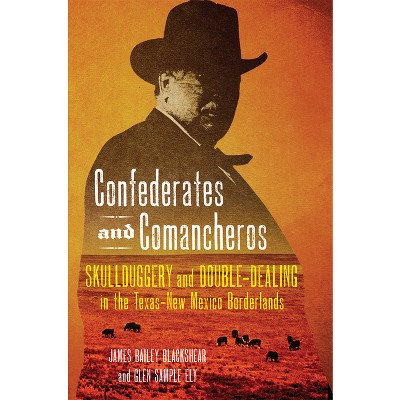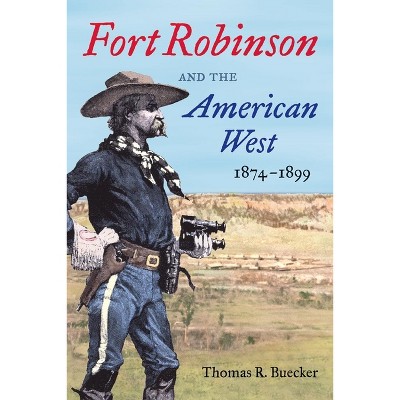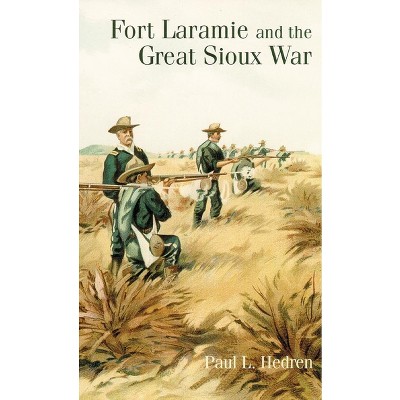Sponsored

Fort Bascom - by James Bailey Blackshear (Hardcover)
$29.95
In Stock
Eligible for registries and wish lists
Sponsored
About this item
Highlights
- Motorists traveling along State Highway 104 north of Tucumcari, New Mexico, may notice a sign indicating the location of Fort Bascom.
- Author(s): James Bailey Blackshear
- 274 Pages
- History, Military
Description
About the Book
In Fort Bascom, James Bailey Blackshear presents the definitive history of this critical outpost in the American Southwest, along with a detailed view of army life on the late-nineteenth-century western frontier. Blackshear shows the difficulties of maintaining a post in a harsh environment where scarce water and forage, long supply lines, poorly constructed facilities, and monotonous duty tested soldiers' endurance.Book Synopsis
Motorists traveling along State Highway 104 north of Tucumcari, New Mexico, may notice a sign indicating the location of Fort Bascom. The post itself is long gone, its adobe walls washed away. In 1863, the United States, fearing a second Confederate invasion of New Mexico Territory from Texas, built Fort Bascom. Until 1874, the troops stationed at this site on the Eroded Plains along the Canadian River defended Hispanic and Anglo-American settlements in eastern New Mexico and far western Texas against Comanches and other Southern Plains Indians. In Fort Bascom, James Bailey Blackshear presents the definitive history of this critical outpost in the American Southwest, along with a detailed view of army life on the late-nineteenth-century western frontier. Located in the middle of what General William T. Sherman called "an awful country," Fort Bascom's hardships went beyond the army's efforts to control the Comanches and Kiowas. Blackshear shows the difficulties of maintaining a post in a harsh environment where scarce water and forage, long supply lines, poorly constructed facilities, and monotonous duty tested soldiers' endurance. Fort Bascom also describes the social aspects of a frontier assignment and the impact of the Comanchero trade on military personnel and objectives, showing just how difficult it was for the army to subdue the Southern Plains Indians. Crucial to this enterprise were logistics, including procurement from civilian contractors of everything from beef to hay. Blackshear examines the strong links between New Mexican Comancheros and Comanches, detailing how the lure of illegal profits drew former military personnel into this black-market economy and revealing the influence of the Comanchero trade on Southwestern history. This first full account of the unique challenges soldiers faced on the Texas frontier during and after the Civil War restores Fort Bascom to its rightful place in the history of the U.S. military and of U.S.-Indian relations in the American Southwest.
Review Quotes
"A significant contribution to frontier military history, this well-documented and readable book establishes the importance of Fort Bascom within the violent struggle to control and terminate commerce between the Comanches and New Mexican Comancheros. The story of Fort Bascom's role in the history of the Southwest has never before been told in such detail."--Leo Oliva, author of Fort Dodge: Sentry of the Western Plains
"James B. Blackshear has come forward with an engaging account of Fort Bascom, a forgotten military outpost in New Mexico Territory along the Canadian River. Based on extensive archival research, Fort Bascom reveals much new information on the U.S. Army's complex role in the histories of violence and trade in a region where the United States, Comanches, Kiowas, and Comancheros competed for positions of power."--Marc Simmons
Dimensions (Overall): 9.1 Inches (H) x 6.3 Inches (W) x 1.2 Inches (D)
Weight: 1.24 Pounds
Suggested Age: 22 Years and Up
Number of Pages: 274
Genre: History
Sub-Genre: Military
Publisher: University of Oklahoma Press
Theme: United States
Format: Hardcover
Author: James Bailey Blackshear
Language: English
Street Date: March 18, 2016
TCIN: 89706160
UPC: 9780806152097
Item Number (DPCI): 247-03-2397
Origin: Made in the USA or Imported
If the item details aren’t accurate or complete, we want to know about it.
Shipping details
Estimated ship dimensions: 1.2 inches length x 6.3 inches width x 9.1 inches height
Estimated ship weight: 1.24 pounds
We regret that this item cannot be shipped to PO Boxes.
This item cannot be shipped to the following locations: American Samoa (see also separate entry under AS), Guam (see also separate entry under GU), Northern Mariana Islands, Puerto Rico (see also separate entry under PR), United States Minor Outlying Islands, Virgin Islands, U.S., APO/FPO
Return details
This item can be returned to any Target store or Target.com.
This item must be returned within 90 days of the date it was purchased in store, shipped, delivered by a Shipt shopper, or made ready for pickup.
See the return policy for complete information.
Frequently bought together

$9.49
MSRP $16.99
Buy 2, get 1 free select books, music & movies
5 out of 5 stars with 1 ratings

$18.88
MSRP $27.00
Buy 2, get 1 free select books, music & movies
4.8 out of 5 stars with 571 ratings
Trending Non-Fiction


$19.31
was $20.98 New lower price
Buy 2, get 1 free select books, music & movies
4 out of 5 stars with 60 ratings

$19.58
MSRP $29.00
Buy 2, get 1 free select books, music & movies
4.6 out of 5 stars with 13 ratings

$4.59
MSRP $7.99
Buy 2, get 1 free select books, music & movies
4.8 out of 5 stars with 120 ratings

$6.20
MSRP $10.95
Buy 2, get 1 free select books, music & movies
4.8 out of 5 stars with 33 ratings

$7.09
MSRP $9.99
Buy 2, get 1 free select books, music & movies
4.9 out of 5 stars with 46 ratings









